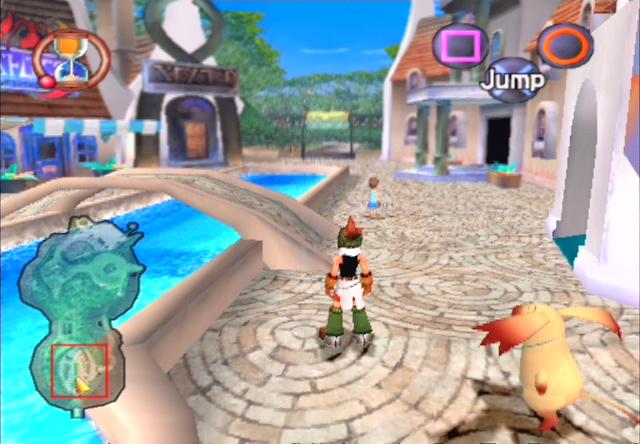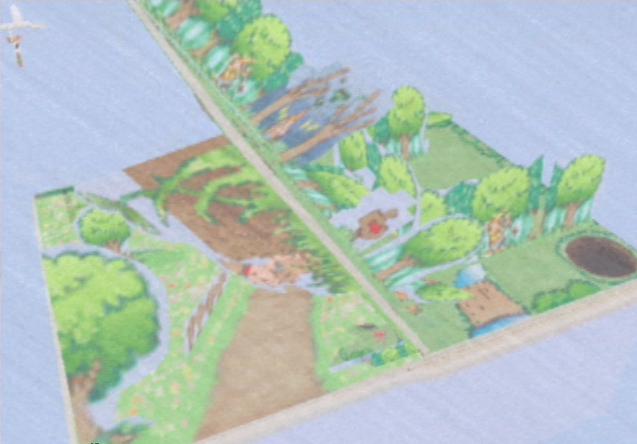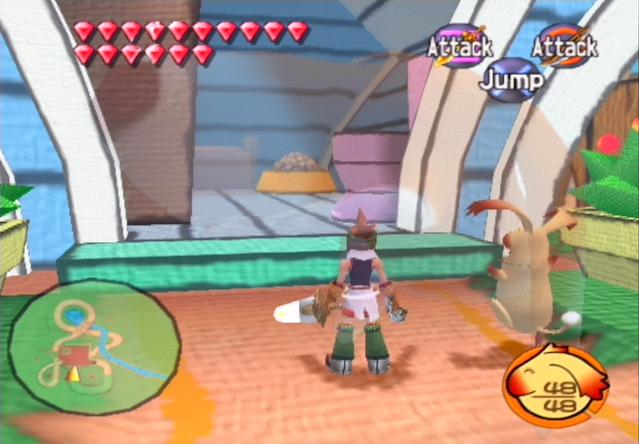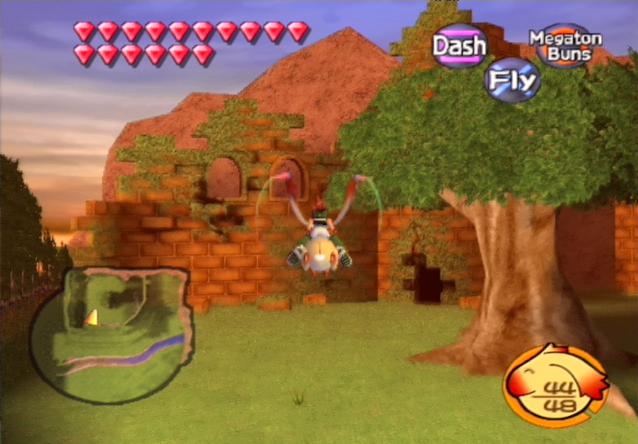An underlooked Action-RPG hybrid
Dual Hearts doesn't seem to have done very well, at least in the west. It had the bad luck to be released at around the same time as Kingdom Hearts (another RPG/platformer) in the US, and as a result got almost completely ignored. And, surprise surprise, it hasn't seen the light of day in the EU.

The one and only town. It's pretty much what you'd expect from an RPG that only has 1 town.
But, what is Dual Hearts anyway, and does it deserve your attention? Well, I can begin to describe it quite easily, because it borrows a lot from Alundra, Zelda 64, and some of Rare's best platforming efforts. It's a platformer crossed with an RPG. The plot is very similar to Alundra, only less dark and more aimed at kids - an evil nightmare threatens to destroy the world, enter people's dreams to collect keys to unlock the seal to it and then destroy it. The gameplay is a lot like Zelda with a jump button. Oh, and there are platforming levels in there as well.
But, the thing that makes Dual Hearts so good, is that it pulls all of these borrowed elements off so well. And if you are a fan of Zelda 64 and platformers, having the two elements done well, and side by side in the same game will bring a smile to your face.

The artist's dream, complete with apples on legs, turtles with faces on their shells and other assorted weirdness.
I should really go into more detail now.
After the opening sequences, and a level which (on your first visit anyway) is really nothing more than a tutorial level, you find yourself on Sonno Island, which serves as a hub level of sorts. The main character seems to be a cut and paste from the Squall school of thought, who's default name is "Rumble" (thank goodness you can change the names...) He's looking for the dreamstone, a legendary stone that is rumoured to be on the island and his main motivation for going through all of this nonsense. However, in order to get at it he needs the keys, which hide away in peoples dreams. Hence he is forced to team up with a strange creature from the dream world called a Baku, which spends the game as his sidekick. (The Baku's default name is "Tumble", again thank goodness you can change them.)

The child's dream is a giant pop-up book, complete with a pastel effect over the top. Very impressive, even if it kills the framerate somewhat
Rumble's abilities are quite similar to Link's, only with a jump button. He can equip 2 weapons at a time, one in each arm, which basically gives him two customisable buttons. At first, the weapons seem to be copied straight from Zelda 64. You can get a sword, a shield, a bow, a grappling shot and a hammer, all of which can be used with a Z-targeting style system, and all of which have been copied straight from Link's equipment. Oh, there are also a spear and a set of throwing cards.
However, Dual Heart's real brilliance seems to come from copying ideas, and then improving them. For a start, rather than just finding better copies of the same weapon later on like in Zelda, in Dual Hearts your weapons earn experience as they are used. Their power and the number of combos that you can do with them all improves as they level up. Also, they have an innovative charge attack. Hold down the button for a little while to charge a weapon, and then let go for something special to happen. For example, the sword's charge move bats enemies and objects away from you. The spear has an amusing charge move that knocks objects and enemies into the sky - thus both hurting enemies, and removing them from battle for a little while until they come down again. These charge attacks are also used a lot in the puzzles as well. Another nice trick are the cards. While you can use them to attack, if you equip them at the same time as another weapon, they will give that weapon elemental properties. As well as opening up the possibility to attack the enemies elemental weaknesses, this is also used quite a lot for puzzles.

A dog's dream. Yes, you can enter the dream of just about anything in the game.
Now to Tumble. He is mostly used for the platforming elements of the game. Quite a lot like Banjo getting a ride off of Kazooie, Rumble can mount him. Tumble moves a lot faster than Rumble can run, plus he can jump further and higher, use a butt slam move, swim underwater, fly using flight pads - a lot like Kazooie in other words. He also handles all the magic in the game (which by the way is what the meter at the bottom right of the screenshots is). He has a few special moves that use magic, but by far the most useful of them is the ability to heal Rumble. There are no magic potions or health pick ups that you can take with you, so if nothing else he is an essential source of healing.
But, possibly Tumbles main ability is that he can allow the pair to enter people's dreams. As long as there is no-one else watching and the target asleep, you can enter the dreams of most people in the game. The dreams serve as the levels of the game. You have to go through a set of fights, platforming bits, and puzzles, then finally you reach the end boss, which usually has a key on it's person. This is the mainstay of the gameplay in Dual Hearts, and fortunately it has been pulled off really, really well, and this is the main reason why I think Dual Hearts is so good.
Another reason though, is the amount of imagination that has been put into some of the dreams. Dreams have a connection to the person they belong to, and usually have some sort of twist. The artist's dream is basically a giant ring-like structure, with gravity pulling you onto the inside of the ring, and consists of lots of things like clocks melting on trees. The architect's dream is a Zelda-64 style ruin. The dream of a girl who is depressed is completely covered in ice, however as she feels better it melts and turns into a grassy park. A child's dream takes place in a giant pop-up book, complete with a pastel effect. Particularly impressive is the way that when you advance to the next page, you see the current one fold up, the page turn, and the next part of the level unfolds.
Not all dreams have keys in them, in fact a large number of them are completely optional. In fact, as you progress through the game, new areas are added to old dreams, which are also completely optional - they're just there if you want to play through more.
The platforming elements are just what you would expect from a good platforming game. There are lots of things to collect, and usually there is a puzzle involved in doing so - and usually a clever puzzle. The one odd thing is, that 90% of the platforming and collecting is completely optional, and there are not many benefits to trying to fully complete the game by collecting every single item. This is very good news to people who hate the idea of Rare-collect-em-ups. However, to the completists who will want to get everything, and those who find that they enjoy the game, it is a bit odd that so much of it is completely optional. To do everything would probably take 30 hours, but you can finish by just going through the plot in 15.

Somewhere, in a big book of rules whereever people write these things, is a rule that every platforming game must have an ice level. It's probably one of the few levels in Dual Hearts which doesn't show much imagination, which is a shame. Note the flying, copied straight off of Banjo Kazooie.
When I was playing through Kingdom Hearts, I often felt that while the gameplay wasn't annoying as such, to be honest it was never that great either and I was really only playing through for the story. In Dual Hearts, it is more or less the other way around. The gameplay is excellent, however the plot, graphics and soundtrack are not up to the standard set by the Disney/Square effort. And, to be honest, I really don't care. They're not bad to the point where they harm the game, in fact I quite like the graphics in a couple of places, and a couple of the tracks are catchy enough, however it's worth noting that none of these are as good as they could have been, had the developers chosen to put the resources into those areas.
And, there are a couple of other niggles. The lock on system, while usually well behaved, sometimes decides to lock on to random bits of scenery when you're trying to target an enemy slap bang in front of you. Another annoying thing is how you restore magic. You must go to the effort of cutting down leaves and waiting for Tumble to suck up and eat the weird flying bugs that come out to refill his magic. Then, there are the bosses. They'd be as good as the ones in Zelda, however you are always told the techniques for beating them before you go in, meaning that all you have to do is follow instructions, rather than finding their weaknesses on your own. Also, while it may be perfectly possible to attempt bosses using skill to dodge their attacks, it's so tempting just to let yourself get hit, heal, then go cut down some nearby bushes to restock Tumble's magic. On the same theme, early on in the game there are a lot of tutorials. You'll often find yourself in the situation where, when you come to something new, it's pretty damn obvious what to do, or it would have been more fun to work it out yourself. However, nine times out of ten, your game is interrupted and one of the nearby characters will give you a quick tutorial. Later on they are skippable, however they all should be like that.

The singer's dream, now unfrozen. Her singing seems to conist of the word "la" repeated over and over again. however for some reason it's not as bad as you'd think.
So, what do I think overall? Well it depends - I really, really, enjoyed this, and judging by a couple of other reviews I've read, from people who only sat down to play this game because they were reviewers and reviewing games is their job, other people have been pleasantly surprised and really enjoyed it as well. No, it's not perfect, but it's been a long time since I've seen a game that is. In fact, if you take to it as I did, you'll easily forgive it it's small flaws.
Score: 9/10
Reviewer's Bias: Strongly for





